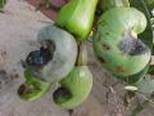-
Die – back or Pink disease: Corticium salmonicolor
-
Damping off: Phytophthora palmivora
-
Anthracnose: Colletotrichum gloeosporioides
-
Inflorescence blight: Colletotrichum mangiferae and Phomopsis anacardii
-
Shoot rot and leaf fall : Phytophthora nicotianae var. nicotianae
1. Die – back or Pink disease: Corticium salmonicolor
 |
Symptoms:
-
It is a very common disease of cashew, often assuming great importance during the south-west monsoon period
-
Whitish or pinkish growth of the fungus can be seen on the affected branches.
-
The fungus penetrates into the deeper tissues and causes the death of the shoots from the tip downwards and hence the name dieback.
-
After heavy rains a film of silky thread of the fungus is seen on the branches.
-
In advanced stages, the bark splits and peels off. Some times only one branch is affected, but often many branches turn yellow and shed giving a barren appearance to a portion of the tree.
|
Management:
-
Prune the affected branches well below the site of infection and destroy them.
-
Protect the cut surfaces by applying Bordeaux paste.
-
If disease is severe, it is advisable to spray Bordeaux mixture (I %).
-
Spraying is to be done twice, once in. May-June and the second during October.
-
Collect all dried up and affected branches to reduce the source of inoculum.
2. Damping off: Phytophthora palmivora
Symptoms:
-
The Disease occurs in nurseries where drainage conditions are poor.
-
The organisms attack the roots or collar region of "seedlings or both the regions and cause their death. when seedlings are infected by Phytophthora palmivora, they become pale.
-
Water-soaked lesions can be observed at the collar region which turn dark and girdles the stem.
-
The seedlings droop and ultimately the plants die.
-
On leaves, water-soaked lesions can be observed in severe cases. These lesions enlarge and coalesce, often covering the entire leaf lamina.
-
All the organisms in combination or alone may cause the disease.
Management :
3. Anthracnose: Gloeosporium gloeosporioides
Symptoms:
-
The disease has been reported in an epidemic form from Tamil Nadu. It is known to cause severe loss in Brazil.
-
The fungus infests the tender leaves, twigs and forms redddish brown, water-soaked lesions. On the affected region exudation of resin can be seen.
-
The lesions enlarge and kill the shoots. The tender leaves are crinkled and fruits shrivelled.
-
The infected inflorescences turn black. Repeated Infection of the terminal shoots leads to the death of the tree in course of time.
Management :
4. Inflorescence blight :Gloeosporium gloeosporioides
Symptoms:
-
This is also a common disease in Kerala especially during the monsoon period.
-
The characteristic symptom is the drying of floral branches. The symptoms appear as minute water soaked lesions on the main rachis and secondary rachis.
-
The lesions are pinkish brown, enlarge and soon turn scabby. Gummy exudates can be seen at the affected regions.
-
The lesions develop into bigger patches and result in drying up of the inflorescences. The incidence is very severe when cloudy weather prevails.
Management :
-
A combination spray of a fungicide (Cuman L 100 ml in 100 litres of water or Blitox 250 g) and an insecticide Dimecron (30 ml in 100 litres) is recommended.
-
It is often claimed that the primary cause of the disease is the tea mosquito and fungi'are only secondary organisms.
5. Shoot rot and leaf fall : P. nicotianae var. nicotianae
 |
Symptoms:
-
During the south west monsoon months of June - August extensive leaf fall and shoot rot symptoms are observed.
-
Black elongate lesions are first developed on the stem with exudation of gum. Later, infection spreads up and down, causing the tender stem to collapse and tender leaves to shrivel up.
-
The lower mature leaves are also infected with black elongated lesions on mid rib, which later spread to the main lateral veins and the leaf blade.
-
The infected leaves are soon shed.
|
Management:
- Spraying with Bordeaux mixture (l %) before the onset of monsoon will check the spread of the disease.
|


